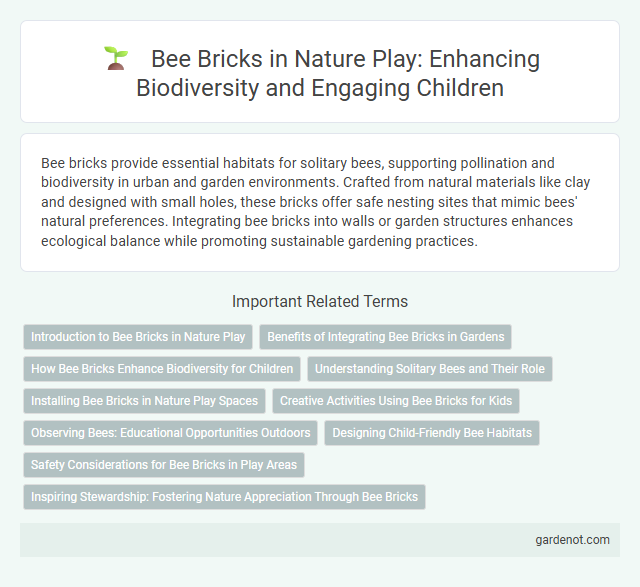Bee bricks provide essential habitats for solitary bees, supporting pollination and biodiversity in urban and garden environments. Crafted from natural materials like clay and designed with small holes, these bricks offer safe nesting sites that mimic bees' natural preferences. Integrating bee bricks into walls or garden structures enhances ecological balance while promoting sustainable gardening practices.
Introduction to Bee Bricks in Nature Play
Bee bricks are innovative, eco-friendly building materials designed to support solitary bee populations by providing natural nesting habitats within urban environments. These bricks incorporate hollow tubes or cavities that mimic natural bee nesting sites, promoting biodiversity and enhancing pollination. Integrating bee bricks into nature play areas fosters environmental education and encourages children's interaction with crucial pollinators in sustainable ecosystems.
Benefits of Integrating Bee Bricks in Gardens
Bee bricks enhance garden biodiversity by providing essential nesting habitats for solitary bees, which are vital pollinators supporting the growth of fruits, vegetables, and flowers. Incorporating bee bricks promotes natural pest control and improves plant health, contributing to a thriving ecosystem. Their integration supports sustainability efforts and fosters environmental education through hands-on interaction with native pollinators.
How Bee Bricks Enhance Biodiversity for Children
Bee bricks provide essential habitats for solitary bees, supporting local biodiversity directly within urban environments where natural nesting sites are scarce. Children observing bee bricks gain firsthand experience with pollinators' roles in ecosystems, fostering environmental awareness and stewardship from a young age. This interaction promotes cognitive development and empathy by connecting children to the natural world through experiential learning and nature play.
Understanding Solitary Bees and Their Role
Bee bricks provide essential nesting habitats for solitary bees, crucial pollinators in urban environments. These solitary bees differ from social species by living and nesting alone, enhancing biodiversity and improving pollination for gardens and crops. Installing bee bricks supports the survival of these important pollinators, contributing to healthier ecosystems and increased plant productivity.
Installing Bee Bricks in Nature Play Spaces
Installing bee bricks in nature play spaces enhances biodiversity by providing solitary bees with essential nesting habitats directly within the play environment. These bricks, embedded with natural materials like hollow stems and small tunnels, support pollinator populations crucial for local ecosystems. Integrating bee bricks encourages children's ecological awareness while fostering a thriving habitat for native bee species.
Creative Activities Using Bee Bricks for Kids
Bee bricks provide an innovative way to engage children with nature through hands-on creative activities such as building bee habitats and exploring pollinator-friendly ecosystems. These bricks encourage kids to learn about biodiversity by designing miniature bee hotels and observing solitary bees in action. Incorporating bee bricks into outdoor playspaces promotes environmental awareness and fosters a deeper connection to wildlife conservation.
Observing Bees: Educational Opportunities Outdoors
Bee bricks provide an innovative way to observe solitary bees in natural habitats, promoting hands-on learning about pollinators and biodiversity. These specialized bricks house bee species such as mason bees, enabling safe nesting and facilitating direct observation of their life cycles and foraging behaviors. Incorporating bee bricks into outdoor educational settings enhances environmental awareness and fosters ecological stewardship among students and nature enthusiasts.
Designing Child-Friendly Bee Habitats
Bee bricks offer a sustainable solution for designing child-friendly bee habitats by integrating nesting spaces directly into garden walls or playground areas. These bricks feature various hole sizes tailored to solitary bee species, promoting biodiversity and supporting pollinator populations. Incorporating bee bricks into nature play environments encourages environmental education and hands-on experiences with native wildlife for children.
Safety Considerations for Bee Bricks in Play Areas
Bee bricks in play areas must be securely installed at heights inaccessible to children to prevent accidental contact and potential stings. Selecting bee bricks made from non-toxic, durable materials ensures long-term safety and environmental compatibility. Regular inspection and maintenance of bee bricks help identify damage or blockages that could pose risks to both children and bees.
Inspiring Stewardship: Fostering Nature Appreciation Through Bee Bricks
Bee bricks are innovative conservation tools designed to support solitary bee populations by providing safe nesting habitats within urban environments. These bricks encourage community engagement and stewardship by inspiring individuals to appreciate and protect vital pollinators essential for biodiversity and food production. Incorporating bee bricks in public spaces fosters awareness of ecological interdependencies, promoting sustainable practices and a deeper connection to nature.
Bee brick Infographic

 gardenot.com
gardenot.com